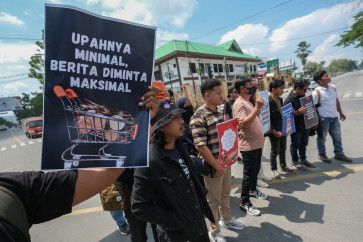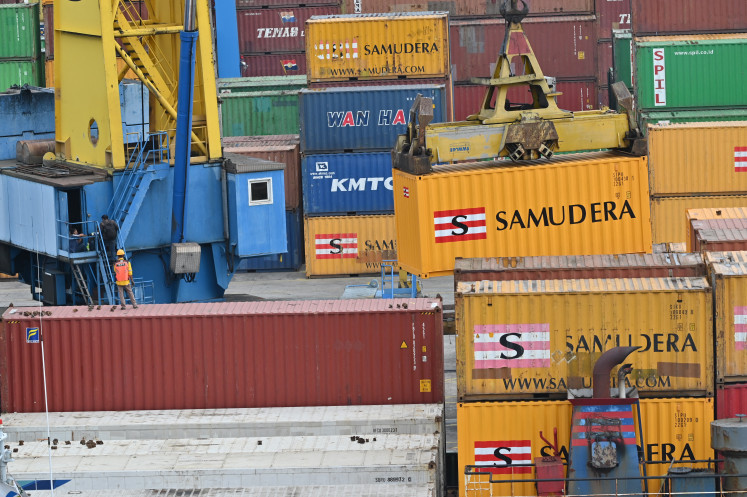After years on streets, app-based motorcycle taxis finally regulated in 2019
The year 2019 marked a new era in app-based motorcycle taxis as the government finally issued regulations years after the ride-hailing services hit the roads in most parts of Indonesia without any regulations
Change text size
Gift Premium Articles
to Anyone

T
he year 2019 marked a new era in app-based motorcycle taxis as the government finally issued regulations years after the ride-hailing services hit the roads in most parts of Indonesia without any regulations.
In March, the Transportation Ministry issued Ministerial Regulation No. 12/2019 on the safety of motorcycle taxis used for the public interest. Ride-hailing companies must comply with minimum standard services in safety, security, amenity and orderliness to ensure protection for drivers and passengers.
In terms of safety compliance, the regulation requires drivers to ride their motorcycle properly with full concentration and to be knowledgeable about the area in which they operate. Drivers should regularly check and take care of their vehicle and ensure vehicle worthiness. Drivers should wear long trousers, shoes, gloves and wear a safety jacket.
The regulation, among other things, requires applicant operators to provide a panic button for drivers and passengers to be used in emergency situations, ensure that each driver’s identity and plate number registered on the app corresponds with that in operation, and provide shelter for drivers to wait, pick up and drop off passengers at strategic locations.
Although these standards have been set and all ride-hailing operators say they have disseminated the new regulations to drivers, implementation in the field is still lacking. In reality, many drivers have not yet complied with these minimum standards such as not wearing shoes and gloves or using vehicles with plate numbers different from those registered. Many drivers also still drive recklessly.
Meanwhile, providing shelters at strategic locations is not easy, especially in Jakarta. Many drivers still flock in certain areas and often block the road near crowded railway stations when picking up and dropping off passengers such as near Palmerah and Tanah Abang stations.
Along with the regulations on safety, the ministry also issued decree No. 348/2019, which sets minimum and maximum fares for the motorcycle taxi services, following a series of protests by the drivers asking for higher fares.
The higher fares were implemented in stages starting from only five big cities in May and reaching all cities across Indonesia by September. At first, passengers complained about the new fares, but as time went by, the public seemed to accept it.
In the new regulation, the fares are categorized in three zones: Zone 1 (Sumatra, Bali and Java — excluding Greater Jakarta), where the price floor is set at Rp 1,850 (13 US cents) per kilometer and the price ceiling at Rp 2,300 per km, Zone 2 (Greater Jakarta), where prices range from Rp 2,000 to Rp 2,500 per km, and Zone 3 (Sulawesi, Nusa Tenggara, Maluku and Papua), where the price range is set at Rp 2,100 to Rp 2,600. The decree also introduced the concept of a fare base for journeys of less than 4 km, which range from Rp 7,000 to Rp 10,000.
The ride-hailing sector has grown sharply, with a compound annual growth rate (CAGR) of 57 percent from 2015 to 2019 with a gross merchandise value (GMV) of $6 billion, according to the annual e-Conomy Southeast Asia study, conducted by American tech giant Google, Singaporean holding company Temasek and management consulting firm Bain & Company.
“The ride-hailing sector is growing rapidly [in Indonesia] due to large funding and tight competition from local and regional players,” said Google Indonesia managing director Randy Jusuf on Oct. 6.
Randy said the growth in the ride-hailing sector was a result of promotions and food delivery services.
The rivalry between homegrown ride-hailing company Gojek and Singapore-based Grab has reached the next level, with the former planning big after a leadership change and the latter stepping up its game in Indonesia including a plan to bring electric vehicles to Greater Jakarta next year.
Gojek cofounder Nadiem Makarim stepped down to join the government as education and culture minister in President Joko “Jokowi” Widodo’s second term Cabinet from 2019 to 2024 while former Gojek president Andre Soelistyo and another Gojek cofounder Kevin Aluwi took over as co-CEOs.
The change came as Gojek, which has operated in Thailand and Singapore in addition to Indonesia, is still waiting for licenses to further expand its international operations into Malaysia and the Philippines.
Gojek, which currently handles 2 billion transactions per year with 2 million drivers and 400,000 merchant partners, is planning to widen its customer base to be half from Indonesia and half from its overseas presence, according to the co-CEOs.
The company is also planning to go public and offer its shares in an initial public offering in two countries, including Indonesia.
Grab Indonesia, which has provided over 4 billion trips since 2012, is planning to introduce electric vehicles (EVs) to Greater Jakarta in January next year as part of a trial service in partnership with local and foreign vehicle manufacturers.
Grab Indonesia's EV trial program will be financed with investment worth Rp 27 trillion from Softbank, a Japanese
conglomerate.
For its own electric taxi service, called Grab Car Electric, Grab will use 20 Hyundai Ioniq electric cars, which have a 380-kilometer driving range with a fully charged 38-kilowatt-hour (kWh) battery, and is planning to use 500 electric cars from Hyundai by the end of 2020.









